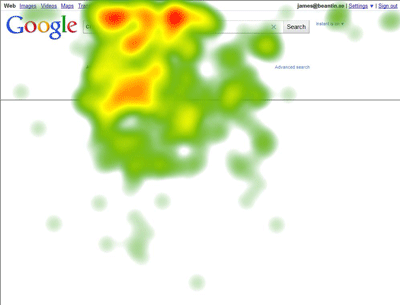Eye tracking Google Instant
This week I did held a number of presentations and demonstrations of eye tracking user testing as part of Per Axbom’s course at Jönköping University. One of the tasks we tested was intended to show how people search using Google with Google Instant enabled.
We tested 6 people, all but one of them were students in their early 20s. The test environment wasn’t exactly how I’d normally set up eye tracking tests (being in a lecture room with 20-30 people watching on a projector screen while you try to solve the task will of course have an impact on the results!).
It’s always fascinating to watch people search – which is why I wanted to show the students a test involving a search engine and information foraging. This though was the first time I’d done any testing with Google Instant enabled.
No-one looked at the ads
Here are some quick findings.
- No-one paid any attention to any adverts. Not once. Not a single fixation on an advert during about 7 minutes worth of Googling by 6 people. What does that mean for paid search?
- When someone did stop typing for a moment to look at the Google Instant SERPs, they looked at the first result.
- Those that looked at the keyboard whilst typing didn’t see the Google Instant results at all.
- Results in positions 1-4 were, by and large, the only ones that received any attention.
It would be nice to do some more digging into the data and pull out a few more findings for you, but time is limited and I want to make sure this post makes the light of day this week rather than next year!

Pulling out heap maps and the like from an Eye tracking test of Google Instant is awkward as the positions of each item in the SERPs varies depending on how many suggestions appear directly below the search box. Sometimes position 1 is where position 2 would be on a normal Google search without Instant enabled.
First result wins
You can see from the heat map above that there is a concentration of fixations around the search box, the instant suggestions, and then the first result. The first result can at times be an advert – but during this test no advert appeared in that position. Note the lack of fixations in the right hand column. Adverts regularly appeared there throughout the tests.
It’s worth noting that Google chose not to do any eye tracking testing of Google Instant before launch, claiming that they didn’t have time. Others have since found the time and published their findings.
The SERPs are more and more complicated
This was by no means a controlled test, and the sample size was just 6 people – but all 6 searched in a way that was clearly their normal and ‘natural’ way of searching. All of them had to solve the same task, and the task had a specific answer that they were unlikely to know before searching. Most of them hadn’t used Google Instant before, so perhaps their behaviour will change as they adjust their search techniques over time.
Nevertheless, Google Instant creates a whole load of issues, and has a varying impact on behaviour. Google search results were already complicated, but the addition of new features such as Instant and Preview during 2010 have pushed this complexity up to a whole new level.
